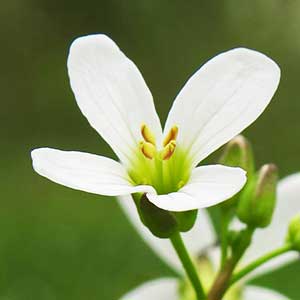Cardamine nymanii
Cardamine penduliflora
cuckoo bitter-cress, lady smock, northern field bitter-cress
wetlands bitter-cress, Willamette Valley bitter-cress
absent.
(tuberiform, fragile), 4–9(–11) mm diam., (fleshy).
erect, unbranched or, rarely, branched, 0.5–1.6(–3.5) dm.
erect or decumbent at base, unbranched, 2–6(–7.5) dm.
(7 or) 9–21-foliolate, (thick, veins impressed);
leaflets petiolulate or sessile;
lateral lobes or leaflets similar to terminal;
terminal lobe or leaflet blade orbicular, broadly ovate to lanceolate, base rounded to cuneate, margins usually entire.
5–13-foliolate, (4–)10–18(–25) cm, leaflets petiolulate or subsessile;
petiole (3–)5–12(–17) cm;
lateral leaflets subsessile, blade similar to terminal, sometimes smaller;
terminal leaflet (petiolule 0.4–0.7 cm), blade oblong to elliptic or ovate, (0.4–)0.7–1.7(–2) cm, base cuneate or obtuse, margins entire or obscurely 3-lobed.
2–4(–7), pinnatisect or pinnately compound, (7 or) 9–21-foliolate, (thick, veins impressed), petiolate, leaflets petiolulate or sessile;
petiole base not auriculate;
lobes or leaflets (of proximal leaves) (4–)7–10 each side of rachis, fewer distally, distal leaves with 4 or 5 lobes or leaflets each side of rachis;
terminal leaflet petiolulate or sessile, blade (or lobe) narrowly lanceolate to lanceolate, base cuneate, margins entire.
2–6, 5–11-foliolate, petiolate, leaflets petiolulate or sessile;
petiole 3–10 cm, base not auriculate;
lateral leaflets sessile, blade similar to terminal, smaller;
terminal leaflet (petiolule 0.5–1.5 cm), blade narrowly ovate or oblong to oblanceolate, 1.5–3.5 cm × 2–15 mm, margins entire or toothed to 3-lobed.
ebracteate.
ebracteate.
sepals oblong or ovate, 3.6–4.4 mm, lateral pair saccate basally, (green with hyaline margins);
petals white-lilac, 9–12.3 × 4.8–6.8 mm, (clawed, apex rounded or emarginate);
filaments: median pairs 3.5–4.5 mm, lateral pair 2–3 mm;
anthers narrowly oblong, 0.9–1.4 mm.
sepals oblong to ovate, 3.5–5 × 1.8–2.5 mm, lateral pair saccate basally;
petals white, obovate, 12–16 × 6–8 mm, (not clawed, apex rounded or subemarginate);
filaments: median pairs 6–7 mm, lateral pair 4–5 mm;
anthers oblong, 1.5–1.8 mm.
erect-ascending, 5–15 mm.
ascending to divaricate, (10–)20–40(–60) mm.
linear, 1–1.8 cm × ca. 1.5 mm;
ovules ca. 16 per ovary;
style ca. 1 mm, (stout).
linear, 2.5–4.5 cm × 1.4–2 mm;
ovules 12–24 per ovary;
style 4–6 mm.
brown, oblong, ca. 1.5 mm.
brown, oblong, 1.8–2 × 1–1.5 mm.
= 56, 60, 64, 80–100.
Cardamine nymanii
Cardamine penduliflora
Cardamine penduliflora is known from Douglas County north into Benton, Lane, Marion, Polk, and Yamhill counties.
(Discussion copyrighted by Flora of North America; reprinted with permission.)
